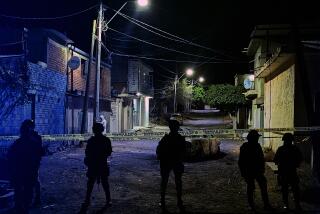Senate Approves Money for New Nuclear Weapon
The Bush administration may get another chance to try to develop a ground-penetrating nuclear warhead. The Senate agreed Friday to revive the “bunker-buster” program that Congress last year decided to kill.
Administration officials have maintained that the country needs to develop a nuclear warhead that would be capable of destroying deeply buried targets, including bunkers tunneled into solid rock.
But opponents say its benefits are questionable and that such a warhead would cause extensive radiation fallout above ground, killing thousands of people. And they say it may make it easier for a future president to decide to use a nuclear weapon instead of a conventional one.
The Senate voted 53 to 43 early Friday to include $4 million for research into the feasibility of a bunker-buster nuclear warhead. The House had refused this year to provide the money, so a final decision would have to be worked out between the two chambers.
The money is included in a $31.2 billion spending measure for the Energy Department and other programs. Last year, Congress killed the program, but the Bush administration asked that it be revived.
Supporters of the program said the $4 million did not signal development of any new warheads. They contend that the money would be used to see whether a sufficiently hardened casing could be developed for an existing warhead so that it could penetrate the ground before exploding and destroy reinforced underground bunkers.
But Sen. Dianne Feinstein (D-Calif.), one of Congress’ most vocal opponents of the bunker-buster, disagreed.
The program “sends the wrong signals to the rest of the world by reopening the nuclear door and beginning the testing and development of a new generation of nuclear weapons,” Feinstein said. “A bunker-buster cannot penetrate into the Earth deeply enough to avoid massive casualties and the spewing of millions of cubic feet of radioactive materials into the atmosphere.”
In April, a panel of the National Academy of Sciences concluded that a ground-penetrating nuclear device would likely cause the same casualties as a surface burst if the weapons were of the same size.
Such a bomb could cause from several thousand to 1 million casualties, depending on its yield and location, according to the report requested by Congress.
At a congressional hearing this year, Linton Brooks, head of the National Nuclear Security Administration, which oversees nuclear weapons programs, acknowledged that there was no way to avoid significant fallout of radioactive debris from use of a bunker-buster warhead.
He said the administration never intended to suggest “that it was possible to have a bomb that penetrated far enough to trap all fallout. I don’t believe the laws of physics will ever let that be true.”
Nevertheless, Brooks and Defense Secretary Donald H. Rumsfeld have argued that a nuclear weapon that can destroy hardened, deeply buried targets is needed in the U.S. arsenal.
More to Read
Start your day right
Sign up for Essential California for news, features and recommendations from the L.A. Times and beyond in your inbox six days a week.
You may occasionally receive promotional content from the Los Angeles Times.






